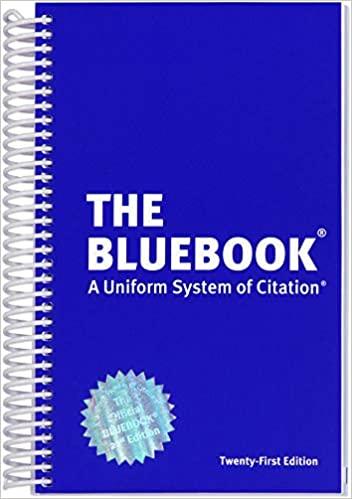Question
Directions: Read the cases below, and based on what we have learned in class about the First Amendment, state how you believe that the Supreme
Directions: Read the cases below, and based on what we have learned in class about the First Amendment, state how you believe that the Supreme Court should rule in the case. Justify your response with reasoning based on the First Amendment.
Establishment Clause:
Zelman v. Simmons-Harris (2002)
When many of the public schools in the poorest areas of Cleveland, Ohio were deemed failures, city officials attempted to rectify the situation by enacting a pilot project on school vouchers for the 1999-2000 school year. The Ohio Pilot Project Scholarship Program distributed money to parents on the basis of financial need, and allowed parents to use the vouchers to pay for their children to attend public or private schools. As most of the neighboring public school districts refused to participate in the program, 96% of students participating in the program attended religiously affiliated schools. A group of Ohio taxpayers sued claiming that the program violated the establishment clause by using taxpayer money to pay tuition for religiously affiliated schools.
Decision:
McCreary County v. ACLU(2005)
The American Civil Liberties Union (ACLU) sued two Kentucky counties in federal district court for displaying framed copies of the Ten Commandments in their courthouses claiming it was a violation of the establishment clause. After losing the first case, the counties modified the display to include eight other smaller historical documents that contain religious references. (i.e. The Declaration of Independence) The ACLU renewed its lawsuit, and on the advice of counsel, the counties changed the display one more time making the documents equal in size and adding commentary on how the documents influence the development of legal precedent in the United States. At the Supreme Court, McCreary County argued that the display was secular in purpose and designed to show the "Foundations of American Law and Government." The ACLU argued the displays violated the First Amendment's establishment clause, which prohibits the government from passing laws "respecting an establishment of religion."
Decision:
Lynch v. Donnelly(1984)
Each year, in cooperation with a downtown retail merchants' association, the city of Pawtucket, R.I. erects a Christmas display as part of its observance of the Christmas holiday season. The display itself contains striped poles, a Christmas tree, carolers, a Santa Claus house, reindeer pulling Santa's sleigh, hundreds of lights, a banner reading "season's greetings", and a nativity scene. The nativity scene contains the traditional figures of the baby Jesus, Mary, Joseph, the Angels, and the Three Kings. Lynch sued the city of Pawtucket for a breach in the establishment clause of the First Amendment of the United States Constitution. He claimed that the $1365 that the city of Pawtucket, R.I. spent on the nativity for the Christmas display was an incident of state-sponsored religion. Furthermore, he claimed that his tax money was being used to sponsor and support Christian beliefs.
Decision:
Free Exercise Clause:
Employment Division v. Smith(1990)
Alfred Smith and Galen Black were fired from their jobs as counselors at a private drug rehabilitation clinic after the owners learned that they had ingested peyote as part of a religious celebration at their Native American Church. Peyote is a hallucinogen that was illegal in the State of Oregon. Both Smith and Black were denied unemployment benefits by the state because they were fired for work-related misconduct. They sued claiming that the denial of benefits was a violation of their free exercise rights of the First Amendment. The Supreme Court analyzed two separate matters in this case. Was the fact that peyote was illegal in the state a violation of their free exercise rights and was the denial of their unemployment benefits a violation of their free exercise rights by conditioning government benefits on an individual's willingness to give up conduct required by their religion?
Decision:
Commonwealth v. Nixon(2000)
Shannon Nixon was 16 years old when she died from Diabetes Acidosis. She and her parents belonged to the Faith Tabernacle Church, a religion in which illnesses are addressed through spiritual healing instead of medicine. When she got sick in 1997, she was 13 years old and her parents and the church community began praying for her health. She got better for a while, but then things got worse until she eventually fell into a coma and died at the age of 16. She never saw a doctor to determine what was wrong with her. During her autopsy, doctors found the cause of death to be Diabetes. Shannon's parents, Dennis and Lorie Nixon were convicted of manslaughter and sentenced to prison terms. They appealed to the Supreme Court on grounds that their sentence violated their and their daughter's right to free exercise.
Decision:
Step by Step Solution
There are 3 Steps involved in it
Step: 1

Get Instant Access to Expert-Tailored Solutions
See step-by-step solutions with expert insights and AI powered tools for academic success
Step: 2

Step: 3

Ace Your Homework with AI
Get the answers you need in no time with our AI-driven, step-by-step assistance
Get Started


